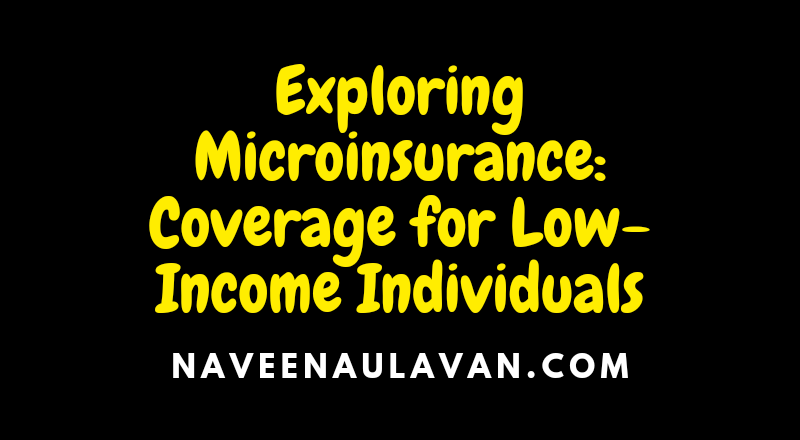In today’s world insurance coverage is considered a crucial component of financial security. However many low-income individuals and families often lack access to traditional insurance products due to affordability constraints. To address this issue microinsurance has emerged as a viable solution. Microinsurance offers low-cost coverage specifically designed to meet the needs of low-income individuals providing them with protection against various risks. This article explores the concept of microinsurance its benefits challenges and its potential to improve the financial security of low-income individuals.
Understanding Microinsurance
Microinsurance is a form of insurance that provides coverage to low-income individuals or those who have limited access to mainstream insurance options. It aims to protect these vulnerable populations from financial shocks by offering insurance products tailored to their specific needs and income levels.
Unlike traditional insurance policies microinsurance policies have lower premium costs and simplified processes. They often cover risks related to health life disability property agriculture and weather-related events. By providing affordable coverage microinsurance helps mitigate the economic burden that low-income individuals may face when unexpected events occur.
The Benefits of Microinsurance
Microinsurance offers several important benefits to low-income individuals and communities:
1. Financial Protection: Microinsurance provides a safety net for low-income individuals shielding them from the potential financial distress caused by unforeseen events. It ensures that they can recover and rebuild their lives after facing risks such as illness accidents crop failure or property damage.
2. Increased Resilience: By having access to microinsurance low-income individuals become more resilient to risks. They can better cope with emergencies and reduce their vulnerability to poverty traps as they have a means to recover and rebuild their livelihoods.
3. Accessible and Affordable Coverage: Microinsurance products are designed to be affordable and accessible ensuring that the coverage is within reach for low-income individuals. Insurance providers leverage innovative distribution channels such as mobile technology community-based organizations and microfinance institutions to reach their target audience.
4. Tailored to Specific Needs: Microinsurance policies are specifically designed to address the risks faced by low-income individuals. By considering their unique needs such as healthcare expenses funeral costs or crop damage microinsurance products provide targeted coverage that is relevant and necessary.
5. Catalyzing Economic Development: By providing financial protection microinsurance contributes to economic development at the individual and community levels. It allows low-income individuals to take risks invest in income-generating activities and access credit or loans more easily stimulating entrepreneurial endeavors and fostering economic growth.
Challenges and Limitations of Microinsurance
While microinsurance has gained traction as an effective tool for financial inclusion it also faces certain challenges and limitations:
1. Low Awareness and Understanding: Many low-income individuals are unaware of microinsurance and its benefits. Lack of understanding and misconceptions may deter potential beneficiaries from purchasing coverage hindering the growth of microinsurance markets.
2. Premium Affordability: Although microinsurance policies have lower premiums compared to traditional insurance they may still be unaffordable for some low-income individuals. Striking a balance between providing comprehensive coverage and keeping premiums affordable is an ongoing challenge for insurers.
3. Insufficient Product Variety: The range of microinsurance products available is often limited as it mainly focuses on life health and agriculture-related risks. There is a need to expand the product range to cover a broader spectrum of risks faced by low-income individuals such as climate-related disasters or non-life risks.
4. Sustainability and Scalability: Building sustainable business models for microinsurance can be challenging for insurance providers mainly due to the low premiums and high transaction costs associated with serving low-income clientele. Achieving scalability while maintaining financial viability is a key concern to ensure the long-term success of microinsurance initiatives.
5. Regulatory Environment: The regulatory framework for microinsurance varies across countries which can pose challenges for insurance providers looking to operate across different regions. A conducive regulatory environment is vital to foster the growth of microinsurance and encourage insurers to offer reliable and affordable products.
The Way Forward
To harness the potential of microinsurance and ensure its widespread impact several stakeholders need to collaborate:
1. Insurance Providers: Insurance companies should invest in product innovation research and development to expand the range of microinsurance products. They should also create awareness and education campaigns to ensure potential beneficiaries understand the benefits of microinsurance.
2. Governments: Governments play a critical role in creating an enabling regulatory environment for microinsurance. They should develop policies and frameworks that support the growth and sustainability of microinsurance encourage innovation and foster consumer protection.
3. Non-Governmental Organizations (NGOs) and Microfinance Institutions (MFIs): NGOs and MFIs can act as intermediaries and distribution channels for microinsurance products. By leveraging their existing networks and relationships with low-income communities they can increase access to microinsurance and facilitate claims settlement processes.
4. Technology Providers: The use of technology particularly mobile technology can significantly enhance the accessibility and affordability of microinsurance. Collaborating with technology providers can enable insurers to reach a wider audience and simplify policy administration and claims processes.
5. Education and Financial Literacy Initiatives: Initiatives focused on educating low-income individuals about insurance and building their financial literacy are essential. Such programs can help overcome misconceptions improve understanding and empower individuals to make informed decisions about their insurance needs.
Conclusion
Microinsurance has the potential to transform the lives of low-income individuals by providing them with accessible and affordable insurance coverage. By protecting them from financial risks microinsurance enhances their resilience encourages economic development and enables them to break free from the cycles of poverty. However overcoming challenges related to awareness affordability product variety scalability and regulation is essential for the successful implementation and growth of microinsurance. With the collaborative efforts of insurers governments NGOs and technology providers microinsurance can be an instrumental tool in improving the financial security of low-income individuals leading to a more inclusive and resilient society.
